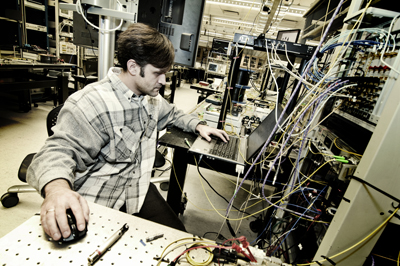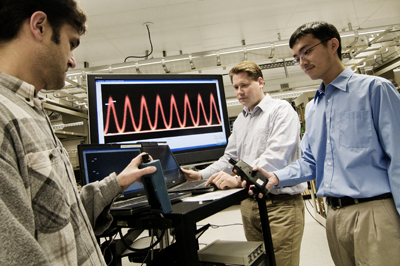Squeezing the Same Amount of Data Through 10 Percent of the Bandwidth
By Walter Ravven, UC with Doug Ramsey/Calit2
Calit2 Researcher Pitches Photonics Research to Venture Capitalists at UC Event
San Diego and Burlingame, CA, April 10, 2012 -- In 2011, UC San Diego research scientist Nikola Alic at the California Institute for Telecommunications and Information Technology (Calit2) received one of 13 commercialization gap grants from the inaugural University of California Proof of Concept Program. His work was selected out of 128 proposals that were eligible for awards ranging up to $250,000. The 12-month grant is allowing Alic, who runs Calit2’s Photonics Systems Laboratory, to bring his research on “Severely Bandwidth Constrained Efficient Communication” closer to commercialization. Last week he pitched the IP to 75 venture capitalists and technology executives at the UC Systemwide Technology Transfer Forum in Burlingame, CA. Following are excerpts from a report on the Forum and “Technologies that can change lives now moving beyond the lab,” by Wallace Ravven, for the UC Research website:
|
At UC San Diego, researchers have devised a way to dramatically boost the amount of digital information that can shoot through fiber optic cables. This addresses the problem of data load and bandwidth in this information age. The project stood on the brink of commercial development. But that’s the rub.
Promising biomedical and engineering discoveries at universities start with federal funding for basic research. Many reach the brink of revealing their real-world potential only to encounter a dreaded funding gap between basic research and commercial application. It’s called the “valley of death” — where cutting-edge innovations come to a grinding halt before they can benefit society.
UC’s Proof of Concept (POC) Commercialization Gap grant program is helping bridge the valley with short-term funding to allow researchers to take that critical step toward commercial viability. In its inaugural year, the program made grants of up to $250,000 for one-year projects to move promising research and make it ready for commercial consideration. Proposals went through a two-tier, rigorous screening: the first by peer scientists and the second by venture capitalists, yielding funding for 13 projects in 2011-12.
|
“Some university research is poised to make a great contribution to health, technology and the state’s economy,” says William Tucker, executive director, Innovation Alliances and Services at the UC Office of the President. “But the university can’t be the investor of first choice. We need to position our ideas so that the value to investors is clear. These are projects where you can easily see their value."
Moving Loads of Data
The human hunger for information seems to have no limit. We’re now up to a billion Internet searches a day and 50 million tweets. We email around the clock and send terabytes of data around the world. Ultimately, almost all digital data and communications flood through fiber optic cables. But there is a limit. It’s called bandwidth.
Fiber optics is the gold standard for heavy loads of data transmission. New research shows that the rate at which data now flows through fiber optic cables has already reached half of the cables’ ultimate limit. The cost of laying down thousands of miles of new, larger cables poses another kind of limit. So, the hunt is on for new technologies to increase bandwidth capacity.
The conventional way of thinking has been that there is a one-to-one relationship between bandwidth and data: Ten gigahertz of bandwidth transmits about 10 gigabits of data. But researchers at UC San Diego’s California Institute for Telecommunications and Information Technology, or Calit2, recognized that 10 times more data can be stuffed — almost literally — into a given bandwidth as long as there is a kind of decoder at the receiving end.
The team conceived of a strategy to transmit data on 10 or more channels within the bandwidth of a single conventional-sized channel. The approach is analogous to compressing video or audio content before streaming it to customers; but instead of digital compression, this strategy physically compresses — or “constrains” — the bandwidth itself.
The constrained communications are more garbled as they come through the cable, but the researchers have shown that the message — the data load — can be fully restored when it reaches its destination.
“We all thought we had to have fat bandwidths to carry large amounts of data. But it turns out that’s not true,” says Nikola Alic, a research scientist at UC San Diego and leader of the new Calit2 communications effort, now funded by a POC grant.
“We find we can cut the bandwidth to 10 percent of the original and still keep as many bits as before. We just need a chip at the receiving end to retrieve the full, original content imbedded in the constrained bandwidth.”
With their POC grant, the team has demonstrated the new technology in the lab and are starting to test its practical use by using 1,000 miles of optic-fiber cables to represent long-distance communication.
“Without the POC grant, it would have been a no-go,” Alic says. “In the last year, we’ve been able to compress data much more effectively, so we can now demonstrate its full potential.”
Alic believes in the new technology’s value and wants to get it into use before data overload forces long-distance fiber optic communication to a screeching halt, or at least a plodding transmission rate.
He says the practical next step would be to fabricate the chips that can unscramble incoming data. If that step is taken, the new technology will be poised to help usher in the next generation of communications capacity.
[Nikola Alic received his Ph.D. in Photonics from UC San Diego’s Department of Electrical and Computer Engineering in 2006, for his pioneering work on the role of electronic equalization in optical communications. He is currently a research scientist at Calit2 in charge of the Photonics Systems Laboratory and Testbed. His research interests include equalization and coding theory in optical communications; high-speed transmission, detection theory, fiber optic parametric amplifiers and all-optical signal processing. Alic has been a co-author of more than 40 peer-reviewed journal publications and has served on Technical Program Committees of OFC, FiO, PhotSoc, as well as IEEE Topical Meetings.]
[To read the complete UC Research article, click here.]
Related Links
Calit2 Photonic Systems Laboratory
UC Proof of Concept Commercialization Gap Grants
UC Systemwide Technology Transfer Forum



